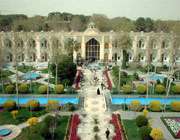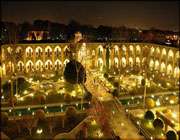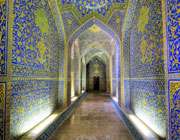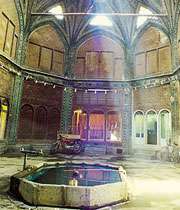Isfahan, The Second Heaven
By: Dr. R. Abouei
Famous Iranian poem: Go to Isfahan to experience the second heaven
With increasing populations almost 20 smaller settlements gradually formed a unified Isfahan during the sixth and seventh centuries. The city has experienced many changes as capital of two great Islamic Empires: Seljukid and Safavid. These changes clearly show the regularity of the urban structure operating during this period. Although the city was the result of two immense urban plans in the eleventh and seventeenth centuries the golden age of Isfahan was in the Safavid era, particularly from 1587 to 1736. In fact, the seventeenth century is portrayed as a period of movement leading to a second period of urban planning in Isfahan towards the end of the century. The city development, to the south of old city, was the most important planned city in Iran which is still considered an outstanding example of urban planning. This regular structure provided the armature on which imperial Isfahan developed especially in the southern extension of the city.

Among the cities of Iran, Isfahan holds an extremely distinguished place, originating in its emergence during the Sassanid period before the birth of Islam. During the reign of Shah Abbas, the new square of the city, a wide straight thoroughfare, the new quarters and the complicated networks of bazaars are the four strongest points for evolution of Isfahan which is described briefly in the paper. Also, the paper provides briefly a chronological and morphological framework to survey the development of the city in seventeenth century of Iran.
Old and New City Centres
Isfahan is situated in a fertile and well-watered area, with a river named the Zayandeh-Roud River flowing through it. Under the name Jay Isfahan appears as a garrison town of the Sassanid period, and in early Islamic times it consisted of two big settlements: Yahudiyeh and Shahrestan (Jay or Gaba). According to historian Balazari it seems that Yahudiyeh and Jey were two important settlements in central Iran in 637. Gradually, with increasing population towns and villages including Forsan, Yavan, Sonbolan, Jey and Yahudiyeh formed a unified Isfahan. A noteworthy city in Sasanid times, Isfahan passed to the Islamic Empire in the mid-seventh century and served as a capital for the province named Gabal or Al-Jibal. According to historian Ibn-e-Rosteh the province included 2300 cities, towns, and villages irrigated with the river Zayande-Roud. His text discusses an extraordinary system as well as a good management plan regarding the allocating of water resources for the province cities.

In the eighth century, Isfahan was witness to the establishment of a new mosque in the town of Yavan. There was a small mosque in Jey before that and the local ruler decided to transfer the religious, commercial, and administrative centres of the city from Jey to the north. Gradually, the residential centres of the city were formed around the mosque. Naser Khosrow, poet and the famous Iranian travel writer, described the city when he arrived in Isfahan on 25th June 1052:
The city has a strong and tall rampart including many gates and fortifications. There are many rivers as well as the nice and tall buildings including a magnificent Friday Mosque which was built in the city centre. According to the records, the total length of the city wall is three and half Farsangs [approx. 14 miles]. I saw many bazaars including one bazaar which 200 moneychangers were working there as well as an alley named Kutaraz consist of fifty caravanserais. Naser Khosro described Isfahan as Persia's most fertile, perfect and beautiful city.

About twenty years later in 1072, Malik Shah was crowned as the Sultan of Seljuk and moved the capital of the Seljukid Empire from Ray (in the south of modern Tehran) to Isfahan. The Seljukid Empire stretched from the shores of the Mediterranean up to the Central Asian Mountains, and Isfahan was the capital of this great territory. In the late eleventh century, the city became one of the most famous cities of Islam and could rival other important Islamic cities such as Baghdad and Cairo.
The city's most splendid time began in 1598 when Shah Abbas the Great (1587-1629) decided to make it his capital and rebuilt it into one of the largest cities of the world. Previously, the old central square of the city lay besides the old Friday Mosque dating back to at least 1200 years and was believed to have been built on the site of Zoroastrian fire temple. Gradually, royal urban planners under Shah Abbas created the new heart of the city to the south of the old city centre named Naghsh-e-Jahan square, an open space between the older Seljukid city centre and the river. The considerable size of the square is about 1700 feet in length and 520 feet in width.

Rather, the royal planners sketched out a plan that would run from the new city centre to the old square including the complicated networks of bazaars, porticoes and many caravanserais which were built during the reign of Shah Abbas. Around the new square, Shah Abbas created the noted six-storey palace named Ali-Qapu which dominates the eastern side of the new square. On the east of the square was built the Sheikh Lotfollah mosque and in the north of the square was the entrance to the Royal bazaar, the Qaysariyah. Also, the new Friday Mosque was created in the south of the square, one of the masterpieces of world architecture. The new square was used for holding festivals, markets and games of polo. Today, the original goal posts are still in the place. The square was completely surrounded by more than two hundred handicrafts shops on the ground floor and the second floor had been allocated for travellers and periodic ceremonial uses.
Towards the South
Gradually, under Shah Abbas, the city was embellished with many fine gardens, bridges, buildings, and roads notably the avenue named Chahar-Bagh which means literally Four Gardens. In 1602, the planners proposed the avenue between the river and the royal gate (Darvazeh-Dowlat) which was extended up towards the south of the city in 1620s. Besides these splendid constructions four urban quarters were created under Shah Abbas named Royal, New Julfa, Abbas-Abad, and Gabrian. At its zenith, under Shah Abbas the Great Isfahan had a population of about 600,000 making it one of the world's largest cities of the time. It may be concluded that the city centre smoothly developed to the south by respecting many historical buildings and the urban fabric which were created in previous eras. Also, the city development policy was concerned for the welfare of the people and sensitively considered the balance between people's day to day necessities and the potential of the existing natural resources.
Source: iranchamber.com
Other Links:
Esfahan
Bridges of Isfahan
Esfahan or Half the world